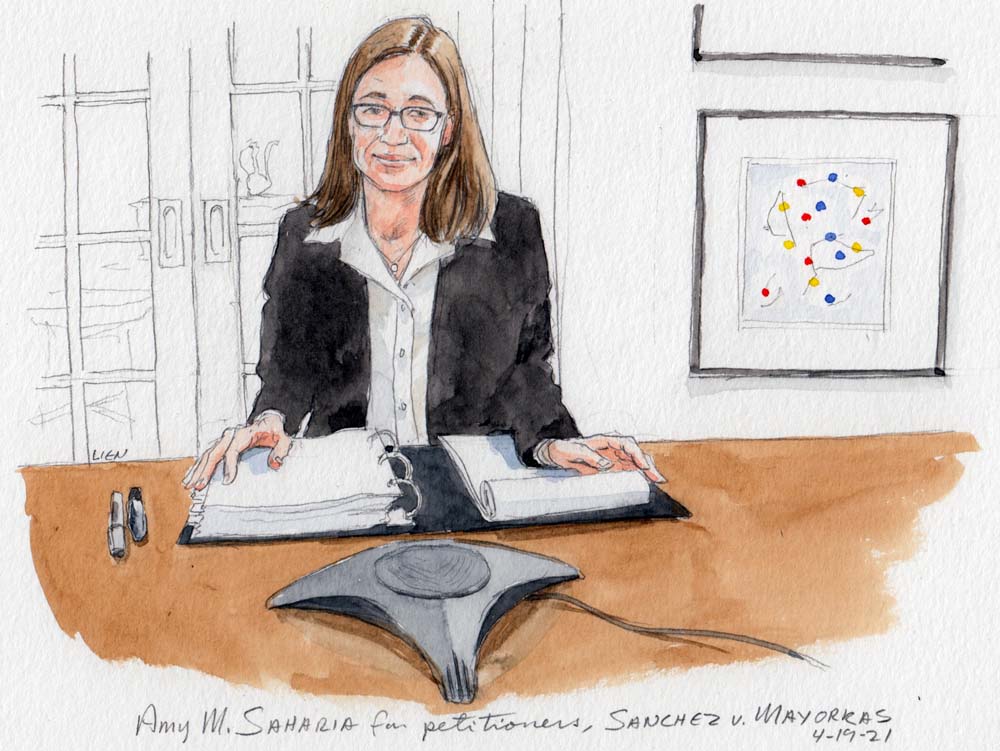Argument Analysis
Skepticism and the shadow of Chevron in Sanchez v. Mayorkas argument

on Apr 22, 2021 at 1:46 pm

The humanitarian stakes were indiscernible in Monday morning’s oral argument in Sanchez v. Mayorkas, which examined whether noncitizens who have been granted Temporary Protected Status are eligible for the statutory procedure known as “adjustment of status” in order to become lawful permanent residents. Only Justice Brett Kavanaugh alluded to the 400,000 individuals granted TPS, most of whom have been living and working in the United States for decades, whose prospects of permanent residence would be eliminated by the Supreme Court’s affirmance of the decision by the U.S. Court of Appeals for the 3rd Circuit. The questioning, instead, was technical, focusing on whether the petitioners, Jose Sanchez and Sonia Gonzalez, had been “admitted” to the United States as required by the adjustment-of-status statute. The approach was textual, the tone skeptical, and the Chevron doctrine hovered throughout. Another issue also garnered attention: whether the Biden administration is considering changing its stance on the statutory issue.
Deciphering the oral argument requires understanding the somewhat obscure underlying immigration procedure. People living temporarily in the United States who are approved by immigration authorities to become permanent residents have two paths to achieve lawful permanent residence. They can return to their homeland and complete the transition there. Alternatively, they can – through the adjustment-of-status process codified in 8 U.S.C. § 1255 – complete the transition to LPR status while remaining in the United States. Only those who have been “admitted” to the United States – a statutory term of art – are eligible for the adjustment-of-status process.
A small portion of those granted TPS were “admitted” to the United States at the outset, but the great majority were not because they entered without authorization. Congress expressly authorized TPS holders to use the adjustment-of-status process, but the parties disagree about whether this authorization extends to all granted TPS, or only to the small number who had been “admitted” at the outset. As a theoretical matter, those denied access to the adjustment-of-status process should be able simply to return to their homeland, complete the transition, and return to the United States as LPRs. As a practical matter, most of those who leave the United States will be barred from reentering for 10 years, even though they have already been approved for permanent residence by U.S. immigration authorities.
The central argument of Sanchez and Gonzalez, a married couple from El Salvador, which has been designated for TPS since a series of devastating earthquakes in 2001, rests on 8 U.S.C. §1254a(f)(4), which states, “for purposes of adjustment of status … [the TPS holder] shall be considered as being in, and maintaining, lawful status as a nonimmigrant.” Since all those with lawful nonimmigrant status have been “admitted,” Sanchez and Gonzalez conclude Congress intended that those granted TPS should be deemed “admitted” for the limited purpose of adjustment of status. The heart of the government’s response is that Congress would have used the term “admitted” in Section 1254a(f)(4) if it had intended to make all individuals with TPS eligible for adjustment of status.
Attorney Amy Saharia, who represented Sanchez and Gonzalez, opened by succinctly setting forth their chief argument, and immediately ran into resistance. Chief Justice John Roberts challenged the logic of the argument, positing that “admitted” nonimmigrants and “lawful nonimmigrants” form two different, though overlapping, categories. Justices Clarence Thomas, Stephen Breyer, Samuel Alito, Elena Kagan and Brett Kavanaugh all pressed this point. The tone was skeptical; the focus textual. Thomas inquired into the “legal fiction” that could allow individuals who had not been “inspected” and “admitted” when they first arrived in the United States to later be transformed into “admitted” nonimmigrants. Saharia took the “legal fiction” comment and made it her own. Legal fictions abound in the legal system, she asserted, and Congress knowingly used the language in Section 1254a(f)(4) — “shall be considered as being” — to signal that a legal fiction should apply: Those TPS holders who had not been “admitted” should be considered as if they had been admitted. Several justices, including Roberts, appeared to reject that argument, commenting that Congress knew how to draft specific language to achieve the desired result. Justice Sonia Sotomayor’s questioning indicated a somewhat more accepting perspective.
Breyer and Alito pursued at some length a related textual question, noting that certain nonimmigrant victims of crime are eligible to remain in the United States on “U visas.” Congress authorized this group to use the adjustment-of-status procedure if they had been “admitted into the United States (or otherwise provided nonimmigrant status).” They pressed Saharia on this seeming statutory acknowledgement that nonimmigrant status could exist apart from admission and did not seem persuaded by her response.
Saharia’s second line of argument also gained little traction. She contended that the government’s interpretation would render superfluous the words “being in” in Section 1254a(f)(4). Only Sotomayor explored this line of reasoning.
When it came time for the government’s argument, Assistant to the Solicitor General Michael Huston faced a barrage of questions about the doctrine of judicial deference to agency interpretation set forth in Chevron U.S.A. v. Natural Resources Defense Council, Inc. and about whether the government had changed its position since the Supreme Court decided to take up the case. Roberts began by chiding the government for not taking a more assertive stance. “Your brief undersold your position,” Roberts said, adding with a touch of sarcasm that it seemed the government was arguing merely that “it would not be entirely unreasonable” for the court to rule in its favor. Roberts then asked whether the government still maintains that the 3rd Circuit’s interpretation “clearly represents the best one in light of the statutory text, structure and context.” Huston responded that this interpretation is the better one.
Later Kavanaugh returned to this theme. He posited three alternative rulings in favor of the government: (1) the government’s interpretation of the immigration statute is reasonable; (2) the government’s interpretation is the better one; (3) the government’s interpretation is unambiguously correct. When pressed for the government’s preferred result, Huston urged the first option. He argued that the immigration agency is charged with administering the immigration statute and that the court generally affords the agency some degree of interpretive flexibility. Huston reiterated this point in a colloquy with Justice Amy Coney Barrett: “The court’s precedents have indicated that the court won’t foreclose the agency in a case like this from considering whether any other alternative is possible.”
Throughout the government’s argument, justices asked whether the court should apply the Chevron doctrine. Breyer posited that the conflicting interpretations offered by the parties suggested that the statue is ambiguous, which would require applying Chevron. Alito reiterated that members of the court have different view on the Chevron doctrine and questioned whether it needed to be addressed. Huston repeatedly urged the court to avoid addressing Chevron and simply rule that the government had put forward the better interpretation of the adjustment-of-status statute. Alito’s next question hung in the air: If we say that “the government has the better interpretation, won’t that foreclose you from later changing your position?” Huston resisted that conclusion, but Alito and Barrett were openly skeptical of his responses.
The questions at oral argument followed directly from the positions the parties set forth in their briefs. The only real surprise was that Justice Neil Gorsuch, who generally actively engages in oral argument, asked no questions of either side.
Overall the justices appeared unconvinced by arguments for Sanchez and Gonzalez. They expressed reluctance to tackle the Chevron doctrine in this setting, which makes it likely they will conclude the statute is unambiguous. That conclusion would deprive Sanchez and Gonzalez of the ability to adjust their status from temporary to permanent residence in the United States. It would also deprive the government of the ability to exercise discretion in favor of tens of thousands of TPS holders approved by immigration officials to become permanent residents. The government may win this case and tie its own hands.


